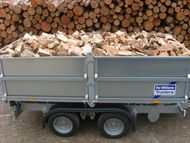HARDWOOD
A deciduous tree that drops its leaves in autumn with the exception of some species of oak, e.g. holm oak that keeps its leaves all year round, deep rooted and slow growing its wood is heavy and dense.
A mature oak tree can draw over 50 gallons of water per day.
After being milled the trunk of the tree has a variety of uses, e.g. construction, furniture etc, the remainder of the tree can be used for firewood, as hardwood is more dense that softwood it takes longer to season.
SOFTWOOD
A conifer( evergreen ) tree that retains its needles all year round with the exception of larch ( a deciduous conifer ) trees which lose their needles in autumn, as they are fast growing the wood is less dense which greatly reduces the time for seasoning as firewood.
Softwood timber has a wide range of uses, the construction of house, farm buildings, fencing etc.
Most softwood trees has a density of 33lb/ft3 compared to an oak which is over 50lb/ft3
CALORIFIC VALUE
Calorific value is the amount of heat produced by a measurement of wood, it can be measured by weight of cubic metres ( m3 ), when measured by weight softwood and hardwood have a similar value, softwood burns quicker than hardwood but as its lighter you need more wood to match the same weight as hardwood. When measured in cubic metres hardwood has a higher value than softwood but hardwood is more expensive to buy.
When calculating calorific value the wood needs to have a low moisture content as wood with a high moisture content is heavier and gives less heat, so you would not get a true value.
